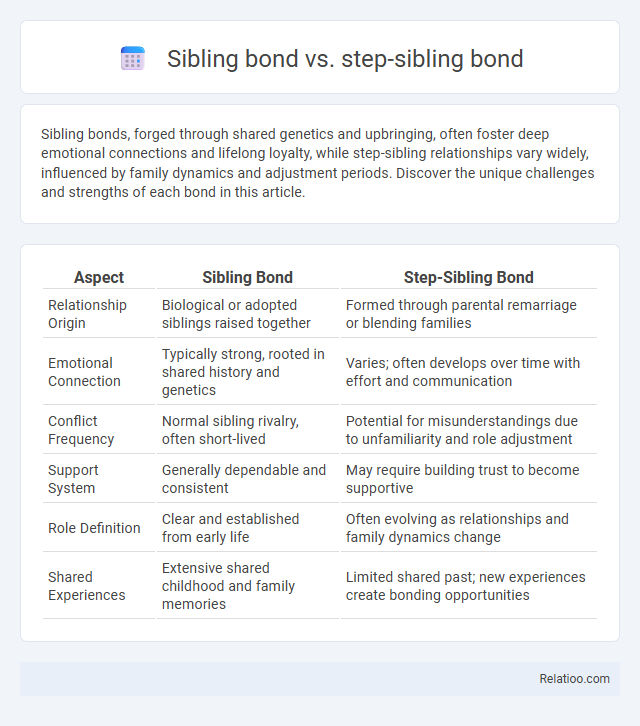Sibling bonds, forged through shared genetics and upbringing, often foster deep emotional connections and lifelong loyalty, while step-sibling relationships vary widely, influenced by family dynamics and adjustment periods. Discover the unique challenges and strengths of each bond in this article.
Table of Comparison
| Aspect | Sibling Bond | Step-Sibling Bond |
|---|---|---|
| Relationship Origin | Biological or adopted siblings raised together | Formed through parental remarriage or blending families |
| Emotional Connection | Typically strong, rooted in shared history and genetics | Varies; often develops over time with effort and communication |
| Conflict Frequency | Normal sibling rivalry, often short-lived | Potential for misunderstandings due to unfamiliarity and role adjustment |
| Support System | Generally dependable and consistent | May require building trust to become supportive |
| Role Definition | Clear and established from early life | Often evolving as relationships and family dynamics change |
| Shared Experiences | Extensive shared childhood and family memories | Limited shared past; new experiences create bonding opportunities |
Understanding Sibling Bonds: Biological vs. Step-Sibling Dynamics
Sibling bonds rooted in shared genetics often foster deep emotional connections marked by lifelong familiarity and mutual support, while step-sibling relationships may require intentional effort to develop trust and closeness due to their non-biological foundation. Family bonds encompass a broader spectrum of relationships, including both biological and step-relations, emphasizing commitment, shared experiences, and emotional investment beyond genetic ties. Understanding these dynamics highlights the importance of communication, empathy, and shared experiences in strengthening both sibling and step-sibling bonds within diverse family structures.
The Psychology Behind Sibling Relationships
Sibling relationships are shaped by shared genetics, early life experiences, and emotional attachment, creating a unique bond characterized by trust, rivalry, and support. Step-sibling bonds often require adaptation and cultivation of trust due to the absence of shared biological history, relying more on communication and mutual respect to develop closeness. Family bonds extend beyond siblings, encompassing broader emotional connectivity and support systems influenced by collective identity, cultural values, and shared family narratives.
Emotional Attachment: Blood Relatives and Blended Families
Emotional attachment varies significantly between sibling bonds, step-sibling bonds, and broader family bonds due to genetic ties and shared experiences. Sibling bonds, rooted in blood relations, often exhibit stronger innate emotional connections and long-term resilience, while step-sibling bonds develop emotional attachment over time through interaction and mutual support in blended family environments. Family bonds encompass both biological and non-biological relationships, where trust, communication, and shared family values play critical roles in fostering emotional closeness beyond genetic links.
Shared Childhood Experiences: Impact on Bonding
Shared childhood experiences play a crucial role in strengthening sibling bonds by creating a foundation of trust, understanding, and emotional connection that often stems from growing up together. Step-sibling bonds, while sometimes initially challenging, can develop deeply when these shared experiences foster new memories and mutual support, bridging the gap between biological ties and chosen family dynamics. Your family bond overall is enriched by these interactions, as the blending of histories and emotional growth cultivates a unique and resilient sense of belonging.
Navigating Jealousy and Rivalry in Sibling Relations
Navigating jealousy and rivalry in sibling relations requires understanding the distinct dynamics between sibling bonds, step-sibling bonds, and broader family bonds. Sibling bonds often include lifelong emotional patterns shaped by shared history, whereas step-sibling bonds may involve challenges in trust-building and acceptance due to initial unfamiliarity. Family bonds, encompassing all members, benefit from open communication, empathy, and conflict resolution strategies to harmonize relationships and mitigate feelings of jealousy and rivalry effectively.
Trust and Loyalty: Differences in Sibling and Step-Sibling Bonds
Trust in sibling bonds often develops naturally over shared experiences and a lifetime of connections, fostering deep loyalty that feels unconditional. Step-sibling relationships may require more intentional effort to build trust, as family dynamics and past experiences influence emotional closeness and loyalty levels. Your understanding of these distinctions helps navigate the unique challenges and strengths within blended families, emphasizing patience and open communication to strengthen bonds.
The Role of Family Structure in Building Connections
The Role of Family Structure in Building Connections shapes how sibling bonds, step-sibling bonds, and overall family bonds develop unique emotional dynamics, trust, and support systems. Your relationships with siblings foster deep-rooted connections based on shared genetics and early experiences, whereas step-sibling bonds often require intentional efforts to build trust and understanding within blended family settings. Family structure influences the availability of shared traditions, communication patterns, and conflict resolution, all critical in nurturing strong, lasting connections among family members.
Parental Influence on Sibling and Step-Sibling Relationships
Parental influence plays a crucial role in shaping sibling and step-sibling relationships, with consistent parenting fostering strong family bonds and positive interactions. Your approach to co-parenting and communication directly affects how siblings perceive each other, often bridging gaps in step-sibling dynamics. Research shows that supportive parental involvement leads to healthier emotional connections and reduces conflicts within blended families.
Overcoming Challenges in Step-Sibling Integration
Step-sibling integration often faces unique challenges due to differing backgrounds and established family dynamics, requiring patience and open communication to build trust and mutual respect. Unlike biological siblings whose bonds are shaped by shared history and genetics, step-siblings must navigate the complexities of blending traditions, parenting styles, and emotional expectations. Your role in fostering empathy and encouraging positive interactions is crucial for transforming step-sibling relationships into strong family bonds.
Strengthening Bonds: Tips for Both Sibling Types
Strengthening bonds between siblings and step-siblings requires intentional effort through open communication, shared experiences, and mutual respect. Encouraging Your willingness to listen and understand each other's perspectives fosters trust and emotional connection, regardless of biological ties. Creating family rituals and spending quality time together can blur differences and build a lasting family bond.

Infographic: Sibling bond vs Step-sibling bond
 relatioo.com
relatioo.com